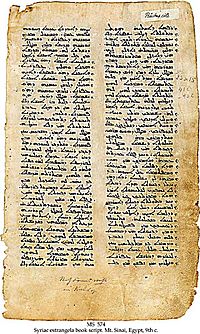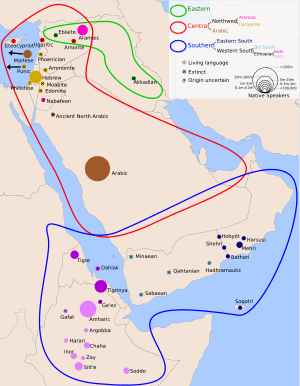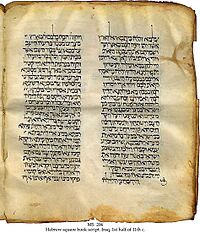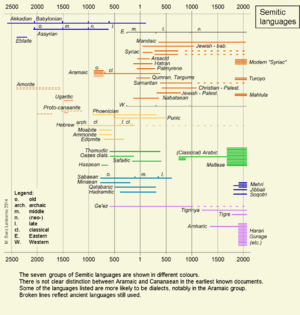Ancient Semitic-speaking peoples facts for kids
The Ancient Semitic-speaking peoples were groups of people who spoke languages from the Semitic family. They lived in places like the Levant (modern-day Syria, Lebanon, Israel), Mesopotamia (modern-day Iraq), the Arabian Peninsula, and Carthage (in North Africa). They lived there from about 3000 BC until the end of ancient times. Some groups, like the Arabs, Arameans, Assyrians, Jews, Mandaeans, and Samaritans, are still around today.
Their languages are usually split into three main groups: East Semitic, Central Semitic, and South Semitic. The very first Semitic language, called Proto-Semitic, probably started in Western Asia around 4000 BC. The oldest writings we have of Semitic languages are from about 2800-2500 BC.
People who spoke East Semitic languages included those from the Akkadian Empire, Ebla, Assyria, and Babylonia. Later, Assyria and Babylonia switched to speaking East Aramaic. Central Semitic languages include Northwest Semitic and Arabic. Northwest Semitic speakers were the Canaanites (like the Phoenicians, Punics, Amorites, Edomites, Moabites, and Hebrews), Arameans, and Ugarites. South Semitic peoples spoke languages like Modern South Arabian and Ethiopian Semitic.
Contents
Where Did They Come From?
Scientists have different ideas about where the first Semitic-speaking peoples came from. Some think it was Mesopotamia, others the Levant, or even North Africa and the Arabian Peninsula. A common idea is that Semitic languages began in the Levant around 3800 BC. They then spread to the Horn of Africa (like Ethiopia) around 800 BC from southern Arabia. They also reached North Africa and southern Spain when Phoenician colonies like ancient Carthage were founded.
Many experts believe that the first Semitic language came from an even older language in North Africa. Perhaps the drying out of the Sahara desert forced people to move around 4000 BC. Some went southeast into what is now Eritrea and Ethiopia. Others went northwest out of North Africa into Canaan, Syria, and Mesopotamia.
The Semitic language family is part of a bigger group called Afroasiatic. Most other branches of this family started in North Africa. This is why some believe the ancestors of Semitic speakers first came to the Middle East from North Africa.
The first clear historical proof of any Semitic people comes from Mesopotamia around 3000 BC. These people entered a region already settled by the Sumerians, who spoke a different language.
The Bronze Age (3000-1200 BC)
Between 3000 BC and 2000 BC, Semitic languages were spoken and written across a large area. This included the Levant, Mesopotamia, Anatolia (modern Turkey), the Arabian Peninsula, and the Sinai Peninsula.
The earliest writings of Semitic languages are found in the Fertile Crescent (Mesopotamia) around 3000 BC. This area included Sumer, the Akkadian Empire, Assyria, and Babylonia. Later, written evidence appeared from the Levant (modern Israel, Lebanon, Jordan, Syria) and the Sinai Peninsula.
By the mid-2000s BC, many cities in Mesopotamia were ruled by Akkadian-speaking Semites. These included Assyria, the Akkadian Empire, Ur, and Babylon. Another East Semitic-speaking group, the Eblaites, appeared in northern Syria around this time. They founded the state of Ebla. The Akkadians, Assyrians, Babylonians, and Eblaites were the first Semitic-speaking people to use writing. They used cuneiform script, which was first developed by the Sumerians. The first writings in Akkadian date back to about 2800 BC.
By the late 2000s BC, East Semitic languages like Akkadian were common in Mesopotamia and northeast Syria. West Semitic languages, like Amorite, Canaanite, and Ugaritic, were probably spoken from Syria to the Arabian Peninsula. The Akkadian language became the main language for writing and literature in the Fertile Crescent. The Old Assyrian Empire and Middle Assyrian Empire helped spread Akkadian as a common language in many areas.
More information is available for the 2nd millennium BC because of the Proto-Sinaitic alphabet, which came from Egyptian hieroglyphs. Proto-Canaanite texts from around 1500 BC show the first clear examples of a West Semitic language. Later, many Ugaritic tablets were found in northern Syria from around 1300 BC.
The Amorites, a West Semitic-speaking people, are mentioned in Mesopotamian records from the 24th century BC. They were seen as wild nomads by the advanced Sumerians and Akkadians. However, these Amorites eventually took over southern Mesopotamia and founded the state of Babylon in 1894 BC. They adopted Mesopotamian culture and language. Babylon became a very important city.
Later, around 1400 BC, nomadic Semitic groups like the Arameans appeared. The Arameans eventually took control of an area that is now Syria, which became known as Aram.
Between the 13th and 11th centuries BC, several small Canaanite-speaking states grew in southern Canaan. These included the lands of the Edomites, Moabites, Hebrews (Israelites), and Ammonites. All of them spoke closely related West Semitic languages.
Around 1900 BC, another group of Canaanite-speaking Semites entered Egypt. By the early 1600s BC, these Canaanites, known as the Hyksos, had conquered Egypt. They brought new military technology, like the war chariot, to Egypt.
The Iron Age (1200-600 BC)

In the first millennium BC, the alphabet spread much further. This gave us more information about Canaanite, Aramaic, and Old South Arabian languages. Phoenician colonies, like Carthage, spread their Canaanite language across the Mediterranean Sea. Its close relative, Hebrew, became the language of important religious books like the Torah.
However, the Assyrian Empire's huge conquests led to Aramaic becoming the main common language (lingua franca) of the Fertile Crescent. Aramaic slowly replaced Akkadian, Hebrew, and Phoenician-Canaanite. Hebrew and Akkadian still remained important for religious purposes. Ethiopian Semitic languages are first seen in writings around 900 BC.
During the Middle Assyrian Empire and Neo-Assyrian Empire, much of the Near East came under Assyrian rule. In the 8th century BC, the Assyrian emperor Tiglath-Pileser III made Aramaic the common language of their empire. Aramaic remained important until the early Middle Ages. It is still spoken today by modern Assyrians and Mandaeans. The Syriac language and Syriac script, a form of Eastern Aramaic, also became very important for spreading Christianity in the Near East.
A Canaanite group called the Phoenicians became powerful along the coasts of Syria and Lebanon from the 13th century BC. They founded city-states like Tyre and Sidon. They spread their influence across the Mediterranean, building colonies like Carthage (in modern Tunisia) around 900 BC. The Phoenicians created the Phoenician alphabet in the 12th century BC, which eventually replaced cuneiform.
The first mentions of Chaldeans and Arabs appear in Assyrian records from the mid-9th century BC.
The Phoenician alphabet became one of the most widely used writing systems. Phoenician traders spread it across the Mediterranean. It changed and was adopted by many other cultures. The Aramaic alphabet, which is still used today, came from the Phoenician script. It is the ancestor of modern Hebrew, Syriac/Assyrian, and Arabic scripts. The Greek alphabet (and later Latin and Cyrillic alphabets) also came directly from the Phoenician alphabet.
Some Semitic-speaking states existed in the Arabian Peninsula, mentioned in Akkadian and Assyrian records. These included Meluhha and Dilmun (in modern Bahrain). Other South Semitic states, like Sheba (in modern Yemen) and Magan (in modern Oman), also existed. The first written evidence of Old South Arabian and Ge'ez languages appeared in the 8th century BC in Sheba and Magan. These languages and the Ge'ez script were later brought to Ethiopia and Eritrea by people migrating from South Arabia.
Classical Antiquity (600 BC - 600 AD)
After the fall of the Neo-Assyrian Empire and the short-lived Neo-Babylonian Empire, Semitic-speaking peoples lost control of the Near East to the Persian Achaemenid Empire. However, the Persians had been influenced by the Assyrians for centuries. Even though the Persians spoke an Indo-European language, they kept Imperial Aramaic as the common language of their empire. Many Semitic nations, like Assyria, Babylonia, and Israel, continued to exist as parts of the Persian Empire.
The main role of Aramaic as an empire's language ended with the Greek Macedonian Empire and its later Seleucid Empire. After Alexander the Great conquered the Persian Empire, his successors made Greek the official language. However, this did not change the languages spoken by most Semitic peoples, who continued to speak Aramaic.
The Akkadian language of the Assyrians and Babylonians, and the Canaanite languages of the Israelites and Phoenicians, slowly declined as Aramaic became more common from the 8th century BC onwards. By the early 1st millennium AD, they had mostly disappeared. However, different forms of Hebrew continued to be used for religious and literary purposes by Jews and Samaritans. The Punic dialect of Phoenician was still used in parts of the Mediterranean ruled by Carthage until at least the 4th century AD.
Aramaic, especially a form called Late Eastern Aramaic, was the common language in Persian-ruled Assyria and Babylonia. It also became important for spreading Syriac Christianity throughout the Near East. Aramaic was also the language of the Aramean state of Palmyra.
Later History
Aramaic languages continued to be the main languages spoken in what is now Iraq, Syria, Israel, Lebanon, Jordan, and parts of Turkey and Iran. This lasted until the Arab Islamic conquest in the 7th century AD.
After this, Arabic slowly replaced Aramaic. This happened as more Muslim Arabs came from the Arabian Peninsula. However, the Syriac language and its literature still influenced Arabic during the Middle Ages.
Today, some Eastern Aramaic languages are still spoken by the Assyrians in northern Iraq, southeast Turkey, northeast Syria, and northwest Iran. The Mandeans of Iraq and Iran also speak them. There are between 575,000 and 1,000,000 speakers in total. The Western Aramaic languages are now almost gone, with only a few thousand speakers left in Syria.
Hebrew survived as the religious language of Judaism. It was later brought back as a commonly spoken language in the 19th century.
See also
- Genetic history of the Middle East
- Proto-Semitic language
- Afroasiatic homeland





